LECCE – THE BAROQUE JEWEL OF PUGLIA
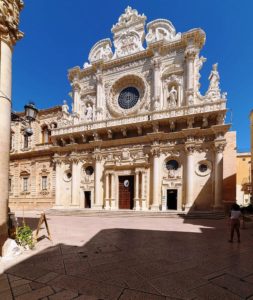
The capital of the province of Puglia, located in the Salento region of the “heel” of Italy, Lecce is a dazzling Baroque jewel. Constructed in the local creamy limestone, the buildings of Lecce are covered with joyous, ornate carvings and adornments executed with exuberance and great skill. It is the cultural capital of Puglia, with so many monuments, churches, palazzi and museums, that it is often referred to as “the Florence of the South”. With its elegant city centre and vibrant lifestyle, Lecce is the perfect destination for the visitor.
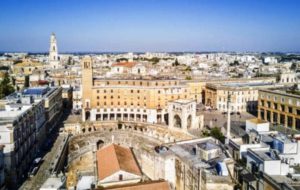
Lecce’s history stretches back over 2,500 years and has emerged as an exotic blend of Greek, Byzantine and European elements, all soaked in the region’s sunshine and mild temperatures and proximity to the Adriatic coast. Good beaches are only 15 mins. away, and marinas hold pleasure craft of all sizes. The city is surrounded by attractive countryside and small towns, making it an ideal base to explore much of the region.
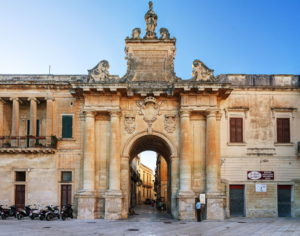
According to legend, a city named Sybar existed at the time of the Trojan War, founded by the Messapii, thought to be an ancient Greek tribe, attested by recent archaeological finds. The settlement suffered successive invasions of the Greeks and Romans, before finally being conquered by the Romans in the 3rd century BC, who renamed it Lupiae.
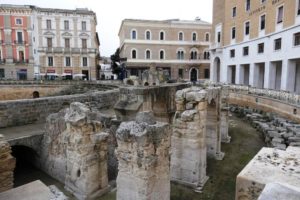
In the 2nd century AD, under the emperor Hadrian, the growing city was moved 3 kms. to the northeast, taking the name of Licea or Litium. Lecce had an amphitheatre and a theatre and was connected to the Hadrian Port (now known as San Cataldo). Orontius of Lecce, locally called Sant’Oronzo, was the city’s first Christian bishop, and is the city’s patron saint. Considerable development took place under the reign of Marcus Aurelius, and the economy flourished. As well as the amphitheatre, the theatre and a forum, the Romans also built city walls above the original built by the Messapii.
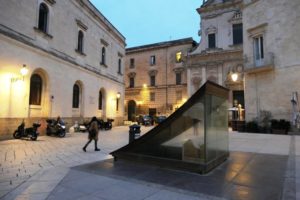
Lecce experienced a turbulent history after the fall of the Western Roman Empire. Sacked by Ostrogoths, then restored to Roman rule in 549, it still managed to remain part of the Eastern Empire for 5 centuries, despite brief conquests by Slavs, Saracens and Lombards and attacks by Turkish pirates. It was conquered by the Normans in the 11th century, when stability allowed Lecce to regain much of its commercial and political importance. It became one of the largest and most important fiefdoms in the Kingdom of Sicily from 1053 to 1463, when it was annexed directly to the Norman Kingdom.
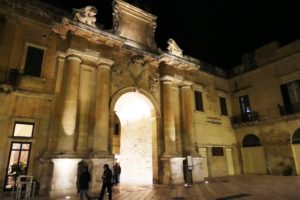
The Norman Counts of Lecce, had sumptuous courts, and considered themselves protectors of arts and literature, and decorated the city with magnificent buildings and a Triumphal Arch. With the death of the last of the Counts of Lecce, the domain lost its autonomy and was incorporated by Ferdinand l of Aragon, the King of Naples. From the 15th century, Lecce was one of the most important cities of southern Italy, and from around 1630, it was enriched with magnificent Baroque monuments.
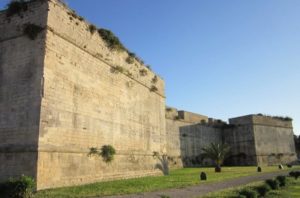
To counteract invasion by the Ottomans, a new line of defensive walls and a castle were built in Lecce by Charles V, the Holy Roman Emperor during the 16th century. The castle was built between 1539 and 1549 on the site of an existing Norman fortress. Its muscular ramparts belie the beauty of the interiors, which feature a delightful central courtyard and a series of halls decorated to suit the tastes of the Holy Roman Emperor. Today, the castle hosts many cultural and artistic events. As a vital component of Charles V’s defensive plans for the region, he also ordered a series of towers and fortifications to be built along the coast of Puglia due to this constant threat. Today, these fortresses are one of the great identifying features of Puglia, and a number of them are open to the public.
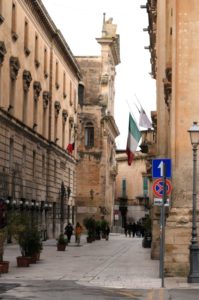
In 1647, Lecce joined Naples in the Revolution of Masaniello, then sided with the Neapolitan Republic. This period of political and social instability was accentuated even more with the terrible plague epidemic of 1656, followed by a number of natural disasters that claimed thousands of victims. As a result, the city suffered a considerable decline. However during the 18th century, in the wake of the Enlightenment, the political and social consciousness of the people of Lecce deepened. Numerous schools, including the school of mathematics and that of law, emerged. This century was also characterised by several episodes of revolt caused by the elevated level of taxes and the arrogance of the ecclesiastical class.
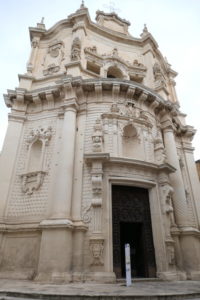
During the Risorgimento, Lecce conspired for national independence and offered refuge to numerous outspoken and very active patriots. After the Unification of Italy, the city began to expand beyond the city walls, and at the beginning of the 20th century, the province of Lecce began an independent path of cultural and economic growth that had positive impacts both on the city of Lecce and the area of Salento as a whole.
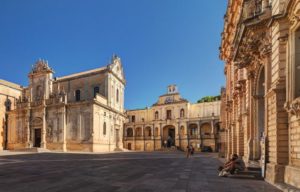
The creamy Lecce limestone has traditionally been one of the city’s major exports, and of course, this stone was used to create most of the city’s palaces, churches and other monuments, due to its soft and workable nature.
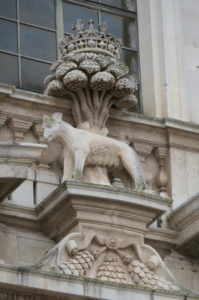
The façades of the 15th and 16th century buildings are extravagantly embellished with cherubs, leaves, flowers, monsters, and every sort of ornamentation imaginable–wherever you look, there are decorated surfaces and ornate doorways. The style is known as barocco Leccese (Lecce Baroque).
Over recent years, Lecce has embarked on a program of restoration and urban
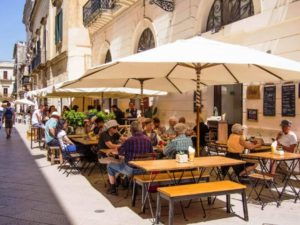
renewal. The historic centre of the city is beautiful, and the visitor can easily spend a couple of days exploring the picturesque squares, pretty little lanes, great bars, cafes and restaurants serving excellent local dishes and refreshments, and marvelling at the city’s great architectural treasures.
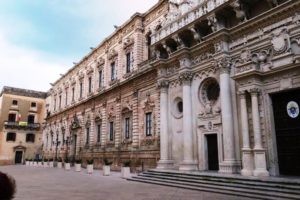
The Basilica di Santa Croce, together with the adjacent former convent of the Celestines, has one of the finest and most intricate Baroque façades in Italy, ornamented with strange beasts and allegories, all executed in the local limestone.
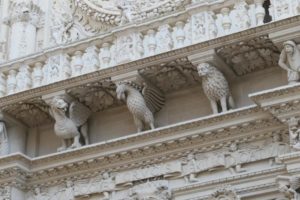
The level of detail is stunning, and the evident perfectionism of its creators most probably contributed to the building’s exceptionally long period of construction—it took over 200 years to complete before it finally opened for worship in 1695. By contrast with its façade, the interior of Santa Croce is not quite as opulent, although it still features some beautiful stonework detail and decoration.
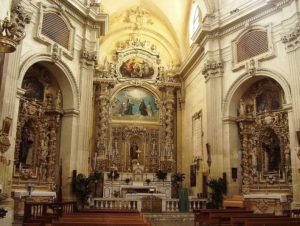
Not far from Santa Croce, you’ll find the church of Santa Chiara. The original construction was completed in 1429, and underwent a complete renovation between 1687 and 1691. The magnificent Baroque façade is slightly convex and does not have a pediment. It echoes the octagonal plan of the interior. Inside, in addition to the majestic high altar, there are six side chapels with as many Baroque altars, decorated with carved timber statues of the Neapolitan school.
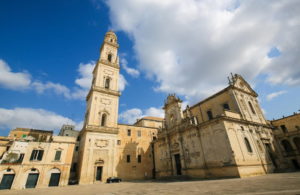
Located in the Piazza del Duomo, Lecce’s Cattedrale Dell’Assunzione Della Vergine is on a par with the Basilica di Santa Croce as the most important church in the city. Constructed in the 17th century, this cathedral also features a Baroque style similar to Santa Croce, and has a beautiful bell tower and a very ornate northern façade embellished with some magnificent statues and sculptures. In contrast to Santa Croce, its interior is highly decorative and features a myriad of gold artwork, opulent arches and a gorgeous ceiling.
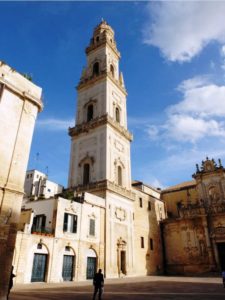
The Cattedrale itself was built originally in 1144, but with the arrival of the enthusiastic practitioners of the Baroque style in the mid-17th century it was given a facelift, and a 70m high campanile was added for good measure.
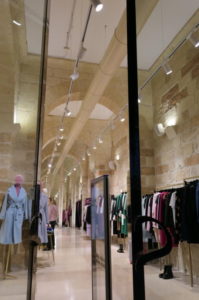
The Piazza del Duomo (cathedral square) is a visual treat, with some of the loveliest architecture in the city, built from Lecce stone. This delightful square is in the centre of the historic centre, and the surrounding streets feature many shops ideal for a little retail therapy, and numerous restaurants, perfect for enjoying an excellent meal and some restful people-watching.
Walking from Santa Croce to Santa Chiara, you will cross Piazza Sant’Oronzo, the most important central square in Lecce, which boasts a cornucopia of architectural styles, the result of centuries of fine craftsmanship. The square has two distinct sides. The north side is an open brick-paved oval-shaped area, and embedded into the floor is a mosaic of the city’s coat of arms, which features a wolf and an oak tree topped by a gold crown.
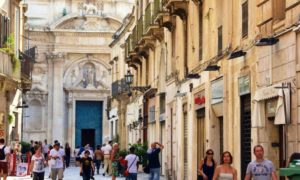
Framing this section of the square are examples of merchant houses and fascist-style architecture. Today, these buildings house fashion stores, fast-food outlets and guesthouses. The oval-shaped area is the setting for markets and concerts–many of which are free to attend—and the yuletide Fiera dei Pupi (Puppet Fair).
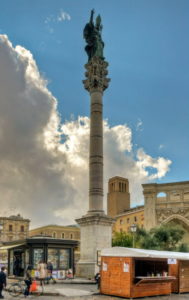
On the south side of the square is the Colonna di Sant’Oronzo, upon which is a statue of St. Orontius of Lecce. Adjacent is the Seat of the Palace, a small palace raised in the 1500s featuring both Gothic and Renaissance aspects. Once a seat of government, it now hosts temporary art exhibitions. Next to this former palace is the Chiesa di San Marco, notable for its Baroque façade.
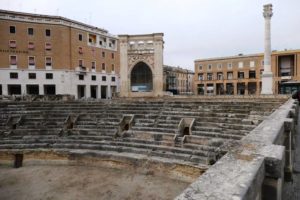
Most importantly though, Piazza Sant’Oronzo is the location of one of the most important archaeological sites in the region: the Roman amphitheatre. This incredibly well-preserved amphitheatre, of which only about half is visible, was accidently discovered in 1929 as construction work was being carried out in the gardens of two nearby historic buildings, Palazzo D’Arpe and Palazzo Romano.
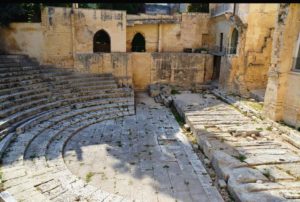
The amphitheatre is not far from the Roman theatre–which is likely to have been commissioned by Augustus before he became Emperor–in the city of Lupiae, the settlement that evolved into Lecce, in which he sought refuge at the time.
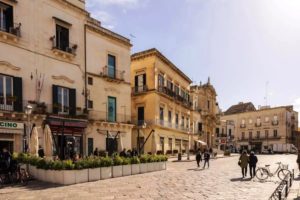
A few metres to the side of the Roman Amphitheatre you will find Caffé Alvino. This is the oldest and most famous café in the city. A stop here is a must to taste some of the best Salento pastries. Don’t miss the pasticciotti filled with a delicious custard, and the cartucce, the traditional iced coffee with almond milk, or perhaps the coffee granita with whipped cream.
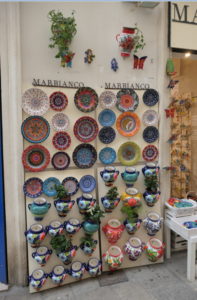
Spend the rest of the afternoon strolling around the centre of Lecce amongst small restaurants, craft stores and beautiful Baroque buildings.
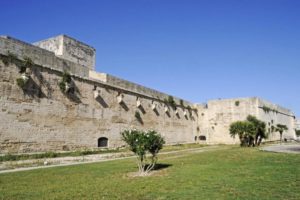
In a huge area, a block or two behind Caffé Alvino is the enormous medieval Castello Carlo V, built in the 12th century and modified in the 16th century by the Spanish emperor. It’s the largest castle in Puglia. Its inner area includes two towers that date back to Norman times, while the outer part was built by the emperor Charles V, that comprises four bastions. There is also a moat and two ancient gates, where you can see evidence of the original drawbridges.
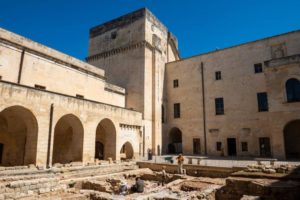
The complex is open to visitors, either with a guide or self-guided multimedia tour through its fascinating dungeons and secret passages, the Chapel of Santa Barbara, the Papier Mâché Museum, and the battlements. Several cultural events and exhibitions are held here during the year.

While strolling back into the centre of the city after exploring Castello Carlo V, we came across a very smart- looking hotel, the Palazzo BN, that had clearly started out life as something else. Curious to see more, we ventured up the front entrance steps and into the foyer to check it out. Elegant and beautifully decorated, we discovered that this former headquarters of the Banco di Napoli had only recently opened, and transformed into what is clearly a temple of gastronomy and fine hospitality.
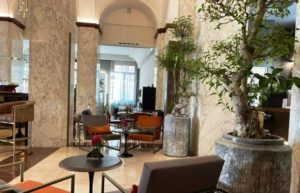
We were invited to have a look through all the public areas, and up on to the roof terrace, which offers a panoramic view over the city. The strongroom in the basement, complete with the former bank’s heavy, safe door, has been converted to a very well equipped gym and beauty parlour. Well worth a look, and its location is sure to make it a popular place to stay in Lecce.
Lecce is one of the loveliest cities in Italy, and is certainly the most important city in Puglia. With dazzling architectural surprises around every corner, wonderful regional food to savour, excellent shopping opportunities, and its central location, Lecce is an absolute must if heading to Italy’s southernmost region.
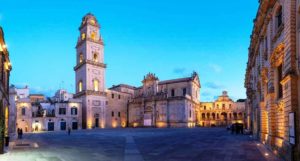


Wow! Cheryl, this is such a fabulously detailed description of an amazing place. So beautiful and so rich in history!
I love your pieces, really makes me want to go there.
Actually saw Lecce on a cooking show recently.
Thanks again,
Diane.
Hi Diane,
Thank you so much for your warm words of praise! I’m so glad you enjoyed the story. Yes, Lecce is an absolute gem and a top must-see for anyone heading to Puglia. Not only is it a lovely city, it’s scale is perfect for exploring on foot, and also its location is ideal for heading to other parts of the region without having to move on too often. By the way, would the cooking program be one of Lyndey Milan’s shows? She’s an old friend (we go to the same gym) and I know she leads regular cooking tours to Puglia and also has a cook book about the local cuisine. She’d been recommending Puglia to me for ages, and so glad we finally managed it.